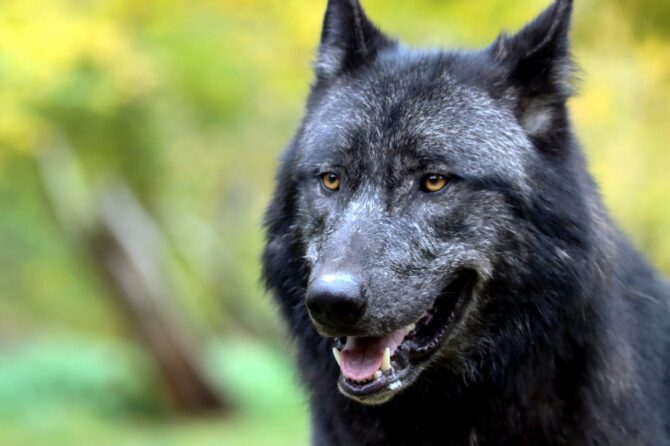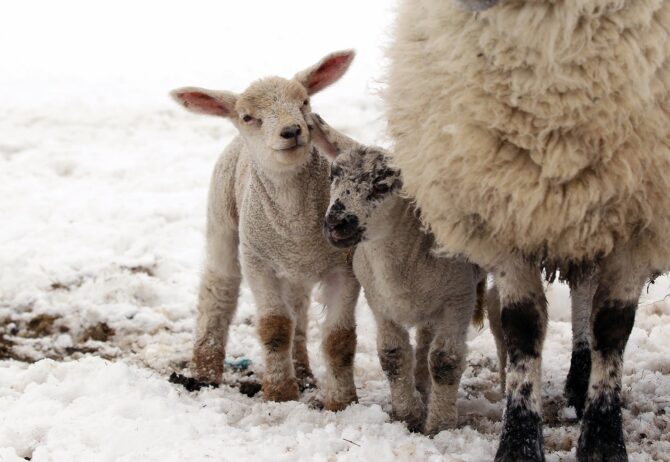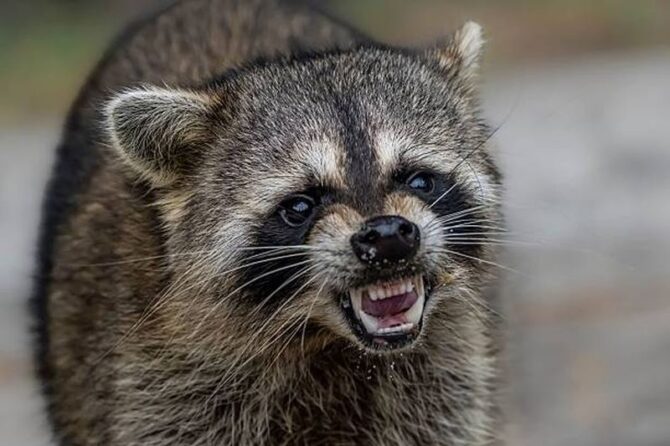The wolf’s fur is usually mottled white, brown, gray, and black, although subspecies in the Arctic region may be nearly all white.
In most parts of the world, black wolves are absent or very rare, yet in North America, they are common in some areas and absent in others.
They are so colored because of a genetic mutation in their K locus gene. This mutation causes a condition known as melanism, an increased presence of dark pigmentation which causes an individual to be colored black (or nearly black). B
lack wolves are also intriguing because of their distribution.
As a spirit animal, this carnivore generally symbolizes an intriguing mix of power, loyalty, guardianship, teamwork, and wildness.
Many cultures traditionally value this animal as a powerful guiding force.
Wolves are extremely intuitive and have an almost supernatural instinct that can detect dangerous situations.
“The wolf that one hears is worse than the orc that one fears.” – J R R Tolkien.
Positive and negative symbols of Black Wolf
Black wolf can certainly be an ominous symbol, but it is also a sign of power.
That’s why usually, it appears as a warning of something negative in our life that can be avoided with our strength or a powerful ally.
The Gwyllgi, the black dog of Welsh folklore, is also known as the “Twilight Dog” or “Corpse Dog” (Cwn Cyrff).
It travels country roads in the form of a large black wolf or mastiff with glowing eyes. #WyrdWednesday #31DaysofHaunting pic.twitter.com/SCsjel796W
— PrairieBones (@PrairieBones) December 6, 2023
Black wolf commonly appears in a dream when something disrupts day-to-day life.
Wolves in folklore, religion, and mythology very often have positive and negative meanings.
Let’s see 15 different mythology and what they say.
| Culture | Symbol |
|---|---|
| 1. Arctic and North America | In many Native American and Arctic cultures, this carnivore is seen as a symbol of leadership, intelligence, and community. In some tribes, it is also associated with the spirit world and is believed to have healing powers.
This animal is often depicted as a teacher or guide, leading humans on spiritual journeys. In Inuit mythology, sometimes depicted as a shape-shifter, able to transform into human form. |
| 2. Turkish | In Turkish culture, this carnivore is seen as a symbol of strength, courage, and nobility. This animal is also associated with the concept of the “grey wolf,” which is a mythological creature believed to be the ancestor of all Turks.
The grey one is often depicted as a fierce and powerful protector of the Turkish people. |
| 3. Slavic | In Slavic mythology, this animal is associated with the god Veles, who is the god of the underworld and the protector of cattle. It is also seen as a symbol of wildness and unpredictability.
In some Slavic cultures, this carnivore is believed to be a shape-shifter, able to transform into human form and deceive people. |
| 4. Mongolian | In Mongolian culture, this carnivore is seen as a symbol of good luck and prosperity. It is also associated with the concept of the “eternal blue sky,” which is a central belief in Mongolian shamanism.
The wolf is believed to be a messenger of the sky gods and is often depicted with a blue mane or fur. |
| 5. Mexico | In Mexican mythology, this carnivore is associated with the god Tezcatlipoca, who is the god of the night sky, sorcery, and destiny. It is also seen as a symbol of the underworld and is believed to have the power to guide souls to the afterlife.
In some Mexican cultures, this animal is believed to be a shape-shifter, able to transform into human form and deceive people. |
| 6. Judaism | In Jewish tradition, the wolf is often seen as a symbol of destruction and chaos. This carnivore is associated with the concept of the “wolf in sheep’s clothing,” which refers to someone who appears harmless but is dangerous.
In some Jewish texts, the wolf is also associated with the concept of redemption and is believed to be a symbol of the coming of the Messiah. |
| 7. Japanese | In Japanese mythology, the wolf is associated with the god Raijū, who is the god of thunder. This animal is also seen as a symbol of protection and is believed to have the power to ward off evil spirits.
In some Japanese cultures, this carnivore is believed to be a shape-shifter, able to transform into human form and deceive people. |
| 8. Roman | In Roman mythology, this carnivore is associated with the god Mars, who is the god of war. The wolf is also seen as a symbol of strength and ferocity.
The she-wolf is a particularly important symbol in Roman mythology, as she is believed to have nursed the founders of Rome, Romulus, and Remus. |
| 9. Iranic | In Iranian mythology, positive and negative context. The wolf is associated with the god Verethragna, who is the god of victory. This carnivore is also seen as a symbol of protection and is believed to have the power to ward off evil spirits.
In some Iranian cultures, this animal is believed to be a shape-shifter, able to transform into human form and deceive people. |
| 10. Greek | In Greek mythology, there is both positive and negative context. This carnivore is associated with the god Apollo, who is the god of music, poetry, and prophecy. This animal is also seen as a symbol of destruction and chaos.
In some Greek myths, this carnivore is depicted as a monstrous creature, such as the wolf that attacked the city of Thebes. |
| 11. Indic | In Indic mythology, the wolf is associated with the god Rudra, who is the god of storms and hunting. This animal is also seen as a symbol of protection and is believed to have the power to ward off evil spirits.
In some Indic cultures, this carnivore is believed to be a shape-shifter, able to transform into human form and deceive people. |
| 12. Dacian | In Dacian mythology, this carnivore is associated with the god Zalmoxis, who is the god of the underworld and the protector of cattle. The wolf is also seen as a symbol of wildness and unpredictability.
In some Dacian cultures, this carnivore |
| 13. German | In German mythology, this carnivore is associated with the god Woden, who is the god of wisdom and magic. This animal is also seen as a symbol of strength and ferocity.
In some Germanic cultures, this carnivore is believed to be a shape-shifter, able to transform into human form and deceive people. |
| 14. Indo-European | In Indo-European mythology, this carnivore is associated with the god of the underworld, who is often depicted as a wolf or a wolf-like creature. This animal is also seen as a symbol of death and rebirth.
In some Indo-European cultures, this carnivore is believed to be a shape-shifter, able to transform into human form and deceive people. |
| 15. Akkadian | In Akkadian mythology, it is associated with the goddess Ishtar, who is the goddess of love, war, and fertility. This animal is also seen as a symbol of protection and is believed to have the power to ward off evil spirits.
In some Akkadian cultures, this animal is believed to be a shape-shifter, able to transform into human form and deceive people. |
“Slowly, deliberately, the dog turned from the black wolf and walked toward the man. He was a dog, and dogs chose men.” – Jim Kjelgaard.
The black species symbolizes the breaking of generational holds, representing the agent of change within familial lineages. Whether found in literature, mythology, or cultural symbolism, the black one embodies rebellion, transformation, and the push for progress.
By daring to challenge the predetermined destinies and expectations imposed by bloodlines, the black one becomes a catalyst for transformative change, pushing families to evolve and grow.
This animal reminds us that we have the power to shape our own destinies and redefine the course of our family’s lineage.
It leads us to question the roles, traditions, and beliefs passed down through generations, encouraging us to break free from the shackles of the past to create a brighter future.
Sources
- https://meaninglibrary.com/black-wolf-symbolism/
- https://www.dreamguideme.com/black-wolf-in-dream/
- https://www.powerfulmystic8.com/sacred-spirit-shaman-blog/2020/10/28/black-wolf-prophecy-and-symbolism
- https://en.wikipedia.org/wiki/Wolves_in_folklore,_religion_and_mythology
- https://www.tiktok.com/discover/what-does-a-black-wolf-mean-in-native-community
- https://inspirationfeed.com/wolf-quotes/






